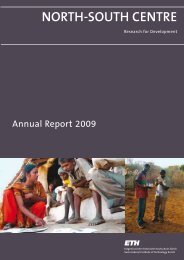Annual Report 2006/07 - ETH - North-South Centre North-South ...
Annual Report 2006/07 - ETH - North-South Centre North-South ...
Annual Report 2006/07 - ETH - North-South Centre North-South ...
You also want an ePaper? Increase the reach of your titles
YUMPU automatically turns print PDFs into web optimized ePapers that Google loves.
ZIL research projectsLivestocksystemsresearchEnvironmentZIL research project, Phase VProject leadersNina Buchmann / Werner EugsterSilvia Dorn / Karsten ModyContact personsSebastian WolfMirco PlathCollaboratorsCatherine Potvin, STRI, Panamaand McGill University, Canada /Hector Barrios, Universidad dePanama and STRI, PanamaDurationJuly <strong>2006</strong> – December 2009Sustainable agroforestry for carbon sequestrationto improve small farmers’ livelihood in the tropicspotentials of the two land use types in Panama. The responsibledoctoral student started in November <strong>2006</strong> and preparedthe set-up of two flux tower sites over winter.Unfortunately, the quality of the old data sets provided byC. Potvin was insufficient for the extraction of flux data orC sink information from earlier times. In November <strong>2006</strong>, aproject meeting took place with partners from Switzerlandand Germany. In January/February 20<strong>07</strong>, the two towerswere installed (after recalibration, upgrades or replacementof old sensors, provided by C. Potvin). First continuous measurementsstarted in February 20<strong>07</strong> (http://biology.mcgill.ca/faculty/potvin/sardinilla.htm). Currently, telecommunicationis established so that data acquisition can be monitored anddata quality remotely checked online.Flux tower at the pasture site at Sardinilla, Panama. CO2 and water fluxesare measured continuously to quantify carbon sequestration potentialsof different land use types in Panama.This project has a twofold objective, investigated in twosubprojects.Subproject 1 aims at assessing the response of plant productivityto future climate change in different land use systemsin Panama, and to quantify their carbon sequestrationpotentials, providing baseline information for adaptive managementdecisions and the very first data sets to policy-makers.Using two flux towers, one in pasture and one in theimproved afforestation system (with native tree species ofvarying plant diversity), water and CO 2 fluxes will be measuredcontinuously in order to quantify carbon sequestrationSubproject 2 aims at taking novel natural-based approachesto increase plant health and reduce insect pests in afforestationand silvopastoral systems. This subproject shall supporttimber tree establishment on current pastures as a futuresource of income to rural poor. New plantations were establishedon the STRI-owned Sardinilla site near Panama City byAugust <strong>2006</strong>, thanks to the close collaboration between the<strong>ETH</strong> Zurich, STRI, the University of Panama and PRORENA.*The pasture-afforestation system focuses on mixed stands ofnative timber trees on pastures planted at relatively highdensity. The nearby silvopastoral system combines pasturewith native timber and selected fodder trees in low densitystands. The trial design was almost completely realisedaccording to our plan. A biweekly survey scheme of plantdamage and associated insects has been implemented, andspecies identification has been initiated, thus taking advantageof insect collections and expertise at the University ofPanama and the <strong>ETH</strong> Zurich.30* The “Proyecto de Reforestación con Especies Nativos” (PRORENA) is a joint venture between STRI and Yale University.
















